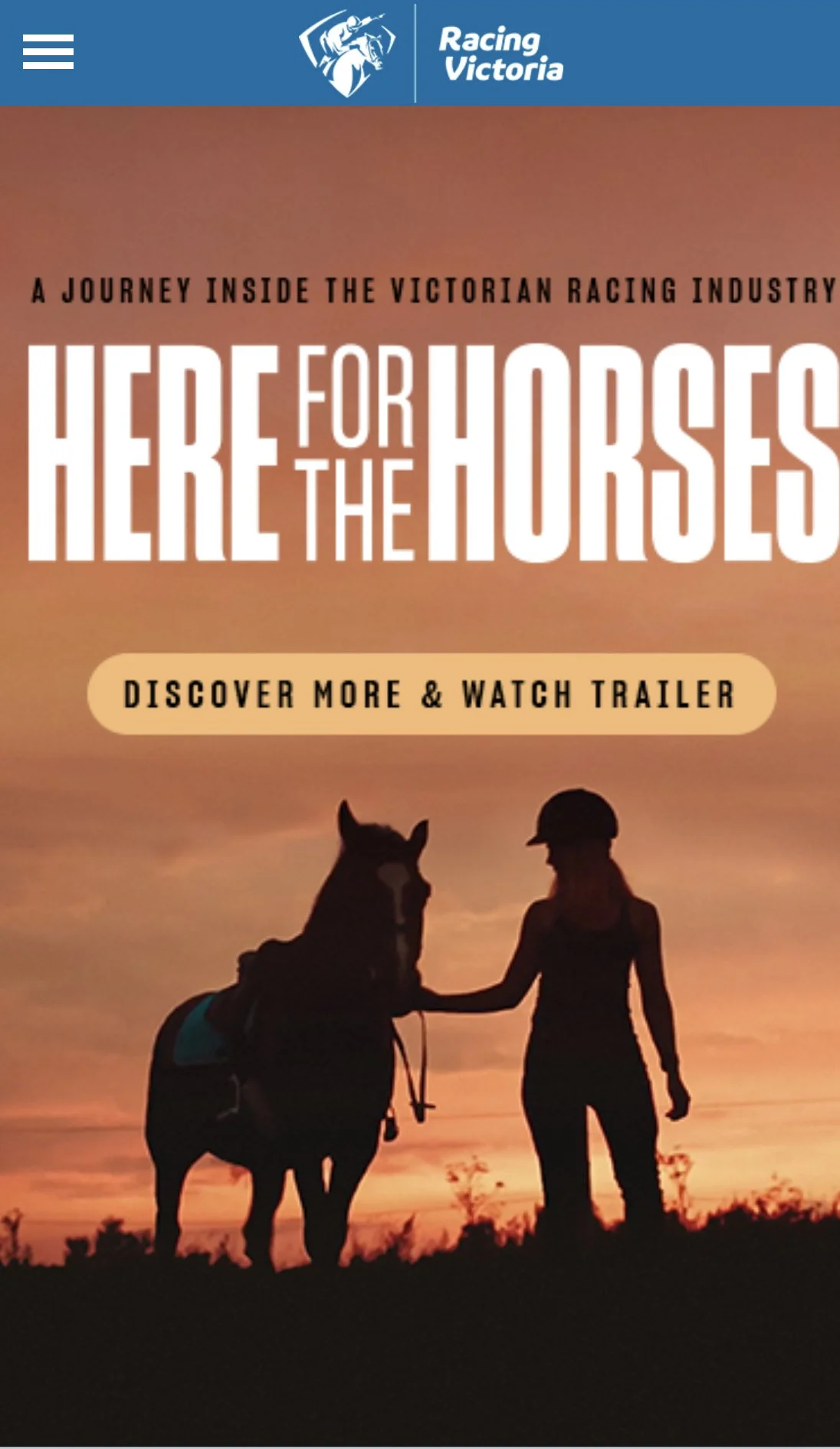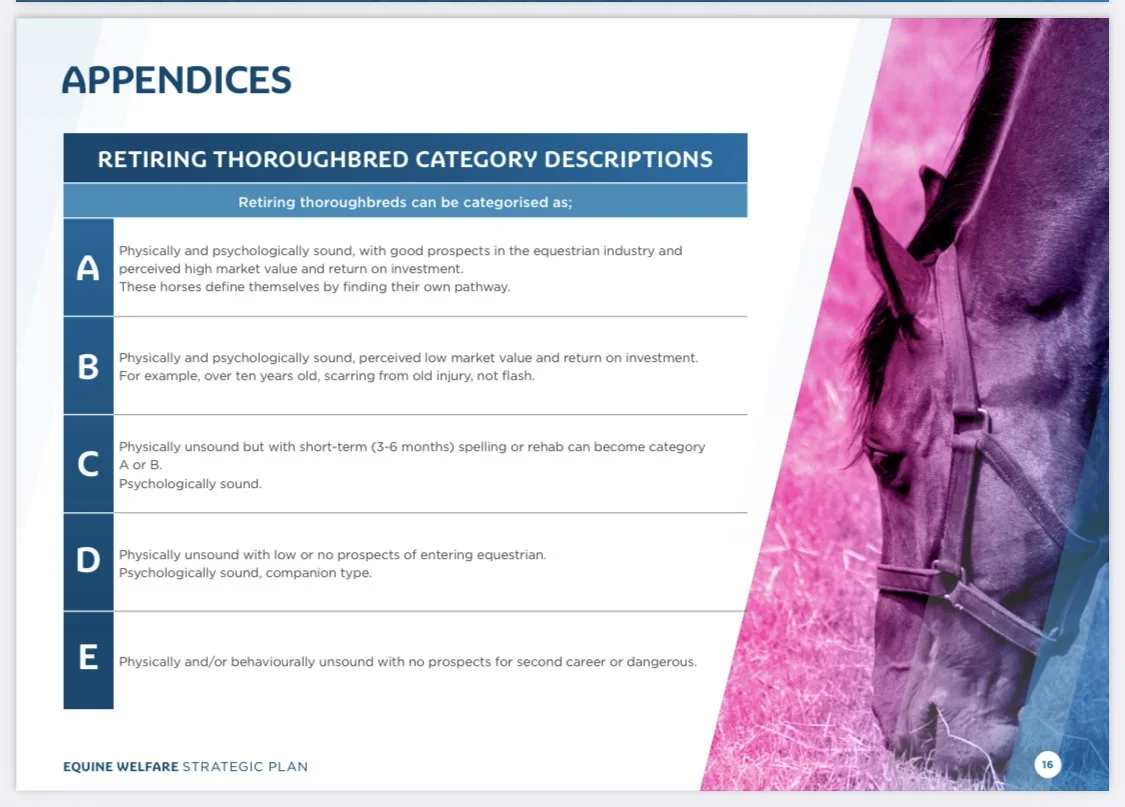Nuffield #21 Racing Victoria
Through my Nuffield there has been one aftercare programme that keeps being mentioned as a flagship example of how to ensure high welfare management of horses exiting racing; that of Racing Victoria in Australia. After the United States Australia is the biggest breeder of thoroughbreds in the world. Jump racing is now banned in all states apart from Victoria, and the state faces public pressure around the high profile Melbourne Cup and previous exposes on the fate of ex-racehorses.
In the face of this racing’s government body in the state has a robust and much respected welfare programme that is underpinned by an objective of making sure that all horses retire from racing mentally and physically sound.
Racing Victoria’s documentary Here for the Horses, which follows racehorses from birth to retirement, was shown on mainstream Australian television
In Victoria a 2% racing levy is directed towards welfare, which helps to fund a seven person strong team and a range of programmes that follow horses from breeding to retirement.
The state has around 3,000 horses entering and exiting training each year, and on retirement around 500 enter the breeding industry as broodmares or stallions. Once they leave racing RV has an objective of tracking every horse into its new career- an ambitious target given that noone even knows how many leisure horses live in Australia. So far around a third of horses that leave the industry are tracked, and there is a dedicated Off The Track community hub for people who own ex-racehorses, alongside a network of approved retrainers.
RV classifies ex-racehorses into one of five different categories depending on their soundness and suitability for a new home. The traceability is especially important for Category A; as the most desirable horses they tend to find their own homes and don’t interact with the welfare team at RV unless they are entered into a competition league or event with the OTT community. Around 20% of Cat A horses are believed to go into eventing, and RV is funneling money into sponsored events, especially those that are underrepresented with thoroughbreds.
New owners are incentivised to register their horses with a range of known behavioural methods such as a live tracker on the website and merchandise. Some Cat A horses pass on to new owners through unofficial brokers who operate outside of the scope of RV, but they want the data to be able to look at horse longevity as well as other post-racing information.
Thoroughbreds are an aspirational breed in Australia and RV don’t shy away from highlighting that they can be much cheaper to buy than a competition horse. There is also work around finding suitable homes for retired breeding stock, and targeted support for vulnerable horses.
The classification of horses is an important tool because it allows RV to channel funding into different strategies for different horses. There is money available for euthanasia of Cat E horses while they are still with their trainers, which avoids the risks of mistreatment associated with these horses leaving racing and falling into the wrong hands. Behaviour and soundness strategies for horses still in training seek to reduce the number of Cat C and D horses.
One of the objectives in the strategy is that all trainers and stable staff receive training on horse handling and positive/negative reinforcement, with one outcome being that fewer horses leave racing unsuitable for rehoming due to behavioural problems.
RV carries out range of industry facing work to engage with trainers and show them what they can offer. Some trainers don’t realise that RV is doing the aftercare work, and the amount of cross-training and prep that individual trainers do to set horses up for new careers varies.
Key aspects of RV’s work are specific programmes such as RESET (Racehorse, Evaluation, Support, Education, and Transition) a scheme designed for horses that are sound and have good prospects but have been unsuccessful in transitioning to a second career. RV pays for these horses to be retrained by an Acknowledged Retrainer and they also undergo a vet assessment. Once sold the profit is split between the retrainer and the horse’s owner- or an equine non-profit if the horse does not have an owner.
Social licence work has also included public outreach. A documentary called Here for the Horses, which follows a racehorse’s life from birth to second career, was shown on mainstream Australian television. Crucially the film was released with the knowledge that it wouldn’t change the opinions of people who are firmly against racing, but it would give those who are agnostic a better picture of what really happens.
Of all the aftercare programmes I’ve seen so far Racing Victoria’s is probably the most aspirational in breadth and depth of support. By integrating aftercare into welfare standard and principles of horses from birth, through racing, and into retirement they are focussing on setting horses up for healthy and happy second careers. It’s been achieved by the racing industry taking full resposibility and ownership of its horses, and has a core message that it is about putting horses first. By investing levy money into welfare they can have world-leading strategies, and by clearly setting out what they want to achieve and how they’ll do it they have accountability in place.
Zooming out to my Nuffield topic, I think there are clear lessons to be learnt from RV’s approach. Taking responsibility to deliver animals ready for their second careers is key, as is owning that responsibility and backing that up with actionable goals. The classification system is clear and shapes strategy, and I think would work well when we look at dairy beef as there are animals bred from dairy cows that have an easy market and need little promotion to be sold, and those who are less suited to the beef market. Clearly euthanasia is not an option, so work would need to be done on taking out those categories by adding value to animals through better genetics and early life management.

